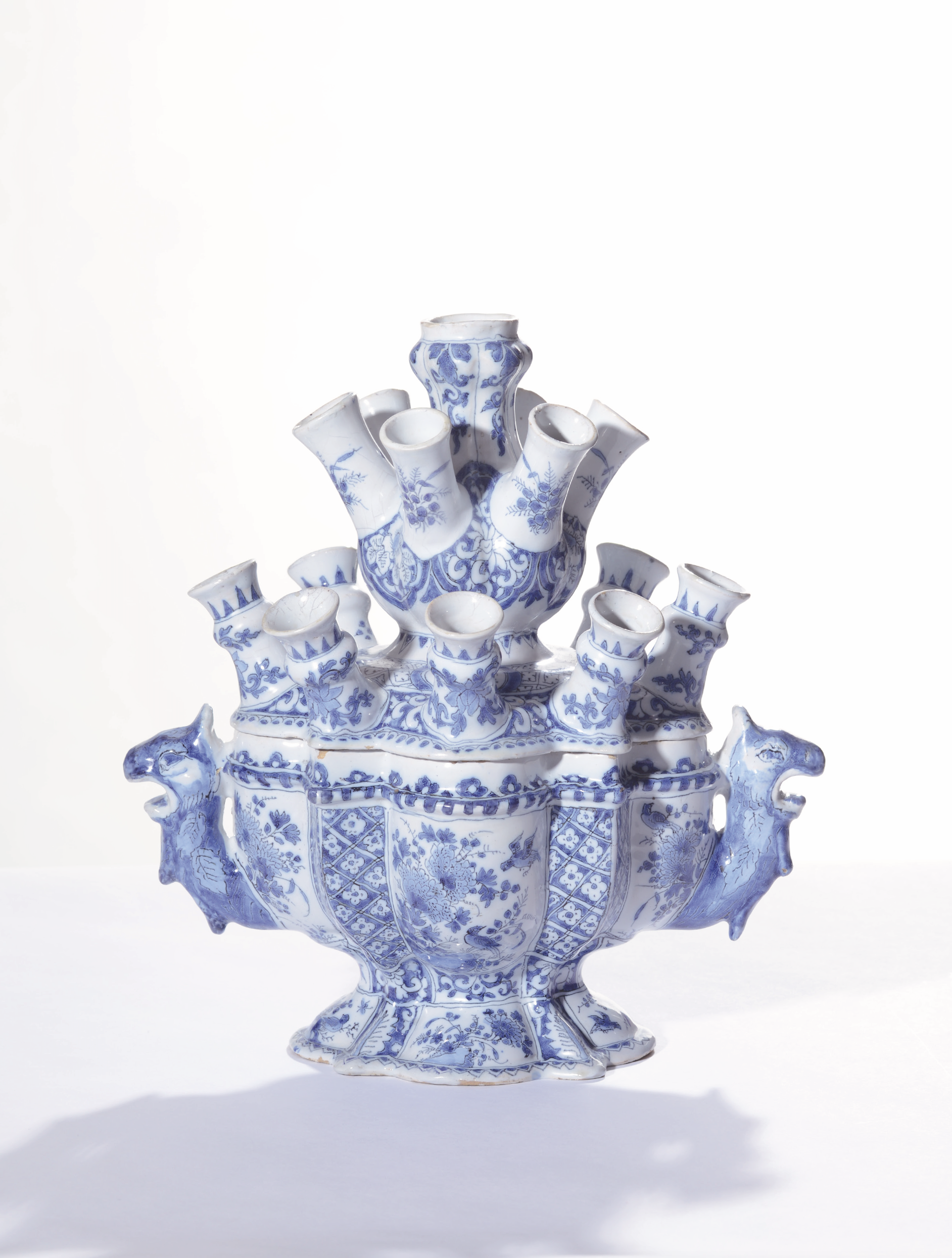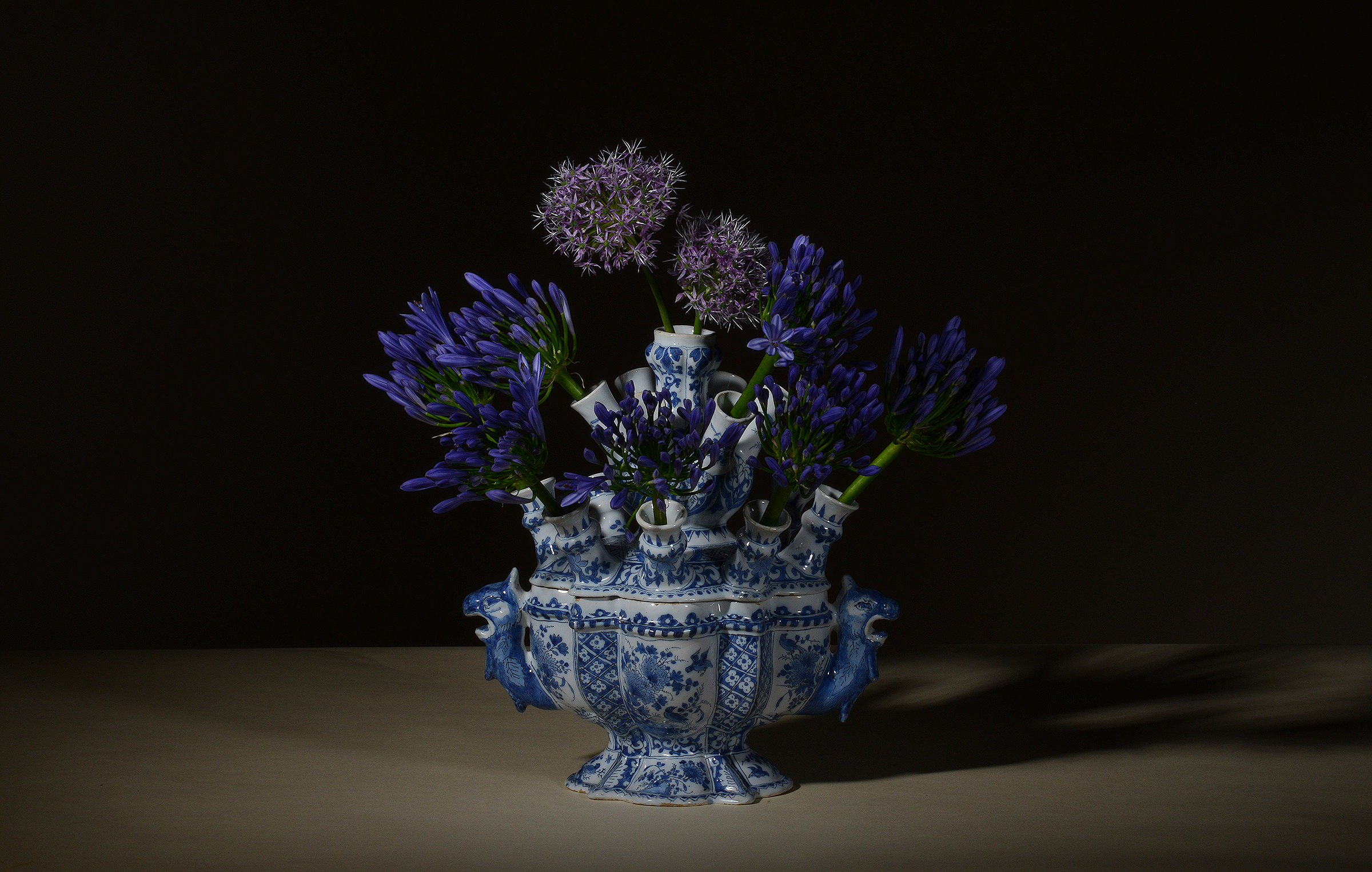
[popup_trigger id=”13756″ tag=”span”]![]() [/popup_trigger]
[/popup_trigger]
Images on this website are licensed under a
Creative Commons Attribution-NoDerivs 3.0 Unported License.

OBJECT
D2118. Blue and White Bowl and Cover Flower Vase
Delft, circa 1695
Marked AK in blue for Adrianus Kocx, the owner of De Grieksche A (The Greek A) factory from 1686 to 1701
The bowl of scalloped and barbed quatrefoil shape, affixed at the ends with blue openmouthed dragon or phoenix head handles, the lobes painted on the front and reverse with birds perched among peonies, foliate and rock work, the barbs with blue ground trelliswork reserved with flowerheads, the conformingly-shaped domed foot similarly decorated with foliate and stylized rock work on all four lobed panels and a leaf device in the barbed panels, above a dentil band around the footrim; the low domed cover rim with a blue ground motif border of floral scrollwork interrupted by eight gu-form spouts decorated on the front with a stylized floral motif and on the reverse with four dots, the center with a trellis diaper work reserved with four blue-edged oval panels with a budding plant encircling a hexafoil bottle-shaped vase decorated with blue ground lappets with floral scrollwork, and issuing from each of the six lobes a slightly flaring cylindrical spout painted on the front with a budding plant, and again at the reverse with four dots, the knopped neck with six floral scroll devices.
Dimensions
Height: 29.3 cm. (11.5 in.)
Provenance
Belgian Private Collection
Similar Examples
The Delft potters developed many different shapes of flower vases. The earliest versions of Delftware flower vases were probably used as reference for the present example; they consisted of a fluted tank on a base with two handles. However, potteries evolved to produce more extravagant table vases in the form of tureens and baskets. A similar example is in the Museum Boijmans van Beuningen, Rotterdam (inv. no. A2807a-b), illustrated by Van Aken-Fehmers 2007, p. 153, no. 3.07. In Van Aken-Fehmers 2007, annex 2, pp. 304- 305, the author identifies fourteen covered vases or bowls of this shape, although with variations in their decoration, and illustrates eight of them on pp. 150-154, cat. nos. 3.03-3.08: a pair from the Kunstmuseum, The Hague ([inv. no. OC(D) 10- 1904], also illustrated in Van Aken-Fehmers 1999, pp. 77 and 106, no. 16; and in Van Aken-Fehmers 2012, pp. 106-107, pl. 48 [back row, center]), along with another pair from the Umeleckoprumyslove Museum, Prague, and four single examples from the Musée Royaux d’Art et d’Histoire, Brussels ([inv. no. Ev. 602 A-B], also illustrated in Helbig, Vol. I, p. 109, fig. 75); the Fitzwilliam Museum, Cambridge and the Centraal Museum, Utrecht. The aforementioned example illustrated as no. 3.03 is illustrated also in Lunsingh Scheurleer 1984, p. 257, ill. 201. All of the known examples of this shape are marked for Adrianus Kocx with the exception of one that is marked for Lambertus van Eenhoorn, the owner of De Metaale Pot (The Metal Pot) factory from 1691 to 1721, which is in the Rijksmuseum, Amsterdam (inv. no. BK-NM-13313), illustrated by Hudig 1929, p. 208, fig. 200. Three further single AK-marked examples are illustrated in Aronson 2004, p. 75, no. 89; Aronson 2010, p. 69, no. 33; Aronson 2015, pp. 51-53, no. 28, an AK-marked pair in Aronson 2017, and another bowl of this model, but with a lower cover formed without the central six-spout section, is in the Metropolitan Museum of Art, New York, illustrated in Aronson 2009, p. 23, fig. 3.








